Benjamin Franklin and Electricity

The study of Benjamin Franklin and Electricity is one of the most popular subjects regarding this American inventor, philosopher and diplomat. Franklin's discoveries in electricity changed the way people in his day understood the world around them and his discoveries still impact us today.
Read on below and follow the story of Benjamin Franklin and electricity - you will learn how he first became interested in electrical phenomena and how his electrical discoveries eventually made him an international celebrity!
Benjamin Franklin and Electricity
The journey of Benjamin Franklin and electricity began in 1743 when Ben attended a lecture on electricity given by Scottish Dr. Archibald Spencer while on a trip to Boston.
Ben was so intrigued with the experiments that he bought some of Spencer's equipment and wrote to his friend Peter Collinson in London to inquire what he knew about electricity. Collinson was the Library Company of Philadelphia's agent in London and he used to buy books and other scientific items for the Company on a regular basis.
 Peter Collinson
Peter CollinsonThe Library Company of Philadelphia was the subscription library started by Benjamin Franklin and his friends. Peter Collinson was a member of the Royal Society, a group of scientists devoted to furthering scientific understanding of the world around them.
Collinson sent the Library Company an "electric tube," a glass tube about two feet long and a few inches across, which was commonly used to transfer electrical charges. The tube would be rubbed with a piece of cloth and then touched to the item one wished to electrify. Collinson corresponded regularly with Franklin about his electrical studies and would one day be responsible for publishing all of Benjamin Franklin's electrical experiments and theories.
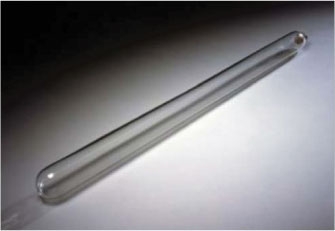 Electric Tube, circa 1747 Source: Frankliniana Database
Electric Tube, circa 1747 Source: Frankliniana DatabaseWith his new found interest in all things electrical, Benjamin Franklin began performing minor electrical tricks such as making a woman's hair stand on end, setting alcohol on fire, giving shocks with a kiss and mysteriously causing an artificial "spider" to move to amuse his friends.
He would use things found around his house to create electrical experiments. In one letter to Collinson, he wrote that, "For my own part, I never was before engaged in any study that so engrossed my attention and my time as this has lately done."
Benjamin Franklin's interest in electricity was so great that he found all kinds of interesting ways to harness its power - he killed a turkey and roasted it on a spit turned by electricity; he sent an electrical current through water to ignite alcohol; he charged glasses of wine so that the drinkers would receive a shock! He was even electrocuted a few times himself, describing the experience like this:
"I inadvertently took the Stroke of two of those Jars thro' my Arms and Body, when they were very near full charg'd. It seem'd an universal Blow from head to foot throughout the Body, and was follow'd by a violent quick Trembling in the Trunk, which wore gradually off in a few seconds. It was some Moments before I could collect my Thoughts so as to know what was the Matter; for I did not see the Flash tho' my Eye was on the Spot of the Prime Conductor from whence it struck the Back of my Hand, nor did I hear the Crack tho' the By-standers say it was a loud one; nor did I particularly feel the Stroke on my Hand, tho' I afterwards found it had rais'd a Swelling there the bigness of half a Swan Shot or pistol Bullet. My Arms and Back of my Neck felt somewhat numb the remainder of the Evening, and my Breastbone was sore for a Week after, [as] if it had been bruiz'd. What the Consequence would be, if such a Shock were taken thro' the Head, I know not." - In a letter to Peter Collinson, February 4, 1751
Benjamin Franklin and Electricity - The experiments begin
By 1747, Benjamin Franklin began conducting a series of electrical experiments that would make him a household name around the world and help pave the way for his crucial involvement with the French government during the Revolutionary War many years later.
It was during this time that Benjamin Franklin discovered what we would today call a positive and negative charge.
 Ben Franklin
Ben FranklinIt was commonly thought during his day that electricity was created by friction, as when a cloth is rubbed against something. But Franklin discovered that electrical charge was held statically in positive and negative quantities in various items and, rather than being "created," electricity is only transferred from one item to another. This is what we today call the principle of conservation of electric charge.
Franklin found that nature always restores the equilibrium of electrical charge between items negatively and positively charged - the reason for all electrical shocks.
In addition to discovering the principle of conservation of electric charge, Benjamin Franklin was the first person to use the terms "positive" and "negative" when referring to electrical charges. Before that, they were referred to as "vitreous" and "resinous."
Franklin began his communications about his studies with Peter Collinson at this time with the following letter:
Philadelphia, March 28, 1747 Sir, Your kind present of an electric tube, with directions for using it, has put several of us on making electrical experiments, in which we have observed some particular phaenomena that we look upon to be new. I shall, therefore communicate them to you in my next, though possibly they may not be new to you, as among the numbers daily employed in those experiments on your side the water, 'tis probable some one or other has hit on the same observations. For my own part, I never was before engaged in any study that so totally engrossed my attention and my time as this has lately done; for what with making experiments when I can be alone, and repeating them to my Friends and Acquaintance, who, from the novelty of the thing, come continually in crouds to see them, I have, during some months past, had little leisure for any thing else. I am, &c. B. Franklin
Franklin began to describe his experiments to Collinson in a letter dated May 25, 1747. In it he talks about an experiment using the charged electric tube, iron shot balls and a cork ball. The experiment demonstrates how the positive and negative electrical charge is passed from one item to another in the following manner:
- Two glass bottles are set a few inches from one another with iron shot balls a few inches thick sitting in the mouth of each bottle.
- A cork ball is suspended between the two shot balls with a silk thread.
- The charged electrical tube is moved near one of the shot balls.
- The result? The cork begins to magically move back and forth between the two shot balls.
- Why does this happen? Because the positive electrical charge is transferred from the tube to the first shot ball. The positive charge in the shot ball repels the negatively charged cork ball. When the negatively charged cork ball hits the other shot ball, the cork becomes positively charged and is repelled again back to the other shot ball which is now negatively charged. Each time the cork touches opposite shot balls its own polarity equalizes with the item that it touches and since equal electrical charges repel, the cork is pushed and pulled back and forth between the two.
The other major thing that came out of these experiments is that Benjamin Franklin found that items that were sharply pointed could more efficiently attract and conduct electricity than bluntly pointed objects and at a greater distance.
He described that a pointed metal object could cause a charged item to discharge its electrical charge when the pointed object was brought to within eight inches or so of the charged object, but a blunt object would only cause the charged object to discharge when brought to within about an inch of the charged object. The reason for this is that the electrical charge is more densely condensed into a small area - the point - and can more easily "jump" to the other object.
This discovery led itself to a practical application which became Ben Franklin's most well known invention - the lightning rod. By placing a pointed object up toward the sky, the electrical charge from a cloud could be safely attracted and dispelled into the ground before a lightning strike occurred.
You can read about Ben Franklin's other inventions here.
Benjamin Franklin and Electricity
The Leyden Jar
Ben Franklin and his friends did extensive experimenting with what is known as a Leyden jar. Leyden jars were created by Dutch scientist Pieter van Musschenbroek of Leiden, the Netherlands and were named after this city. Leyden jars were commonly used in Franklin's day to store and transfer electric charge.
The design of a typical Leyden jar was a glass bottle partially filled with water with a metal foil coating the inside of the bottle and another metal foil covering the outside of the bottle with a metal wire extending from the inside of the bottle to the outside through a cork plug.
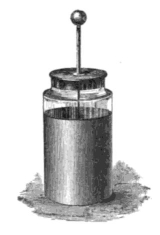 Leyden Jar
Leyden JarElectrical charge was stored up in the jar by touching the conducting wire to an electrical source such as the aforementioned electric tube. Positive electrons would gather on the inside foil, negative on the outside, thus making a perfect electronic storage device.
It was initially thought that the electricity was stored in the water, but Benjamin Franklin found that it was actually stored in the glass. Later it was determined that just about any item could act as the storage device, but that different items would conduct and store electricity at different rates.
In a letter written in 1748, Franklin described to Collinson how the Leyden jar could be positively and negatively charged, the first time these terms were used in relation to electricity. He also, for the first time, used the terms charging and discharging when describing the transfer of electricity from one object to another. He described his discovery that the charge was held in the glass of the jar itself.
In order to further study the properties of the electrical storage of glass, Franklin constructed what he called an electric battery of glass window panes and thin lead plates. With them he demonstrated how electricity could be passed through and stored in the glass itself. This is the first description of an electrical battery and the first time such a term was used.
Benjamin Franklin and Electricity
The lightning rod
Around 1749, Franklin first wrote to Peter Collinson about his supposition that a finely pointed object could be used to extract electrical discharges from clouds. It was commonly believed by scientists in that day that there may be a connection between lightning and electricity, but it was not known for sure. Franklin noticed twelve things about lightning and electricity that were common and this led him to believe that they were one in the same. He then devised an idea to test the hypothesis - an idea that made him a world famous man.
Twelve things held in common by lightning and "electrical fire:"
- Giving light.
- Color of the light.
- Crooked direction.
- Swift motion.
- Being conducted by metals.
- Crack or noise in exploding.
- Subsisting in water or ice.
- Rending bodies it passes through.
- Destroying animals.
- Melting metals.
- Firing inflammable substances.
- Sulfurous smell.
And Franklin's conclusion? "Points attract the electric fluid. We do not know whether this property is in lightning. But since they agree in all particulars wherein we can already compare them, is it not probable they agree likewise in this? Let the experiment be made." - He described this in a letter dated March 18, 1755 to John Lining.
Benjamin Franklin and Electricity - Begins to postulate about lightning
Franklin had already discovered that by holding a blunt metal rod toward an electrified object a loud and noisy spark would be created when the rod got to about an inch from the electrified object. He also found that by holding a sharp metal rod toward the electrified object, a quiet and pale spark was created between the two at about seven or eight inches distance. He wondered if, as his theory suggested, a sharp metal object held toward a thundercloud would also produce the same effect, thus drawing the electrical charge out of the cloud. This is the first description of the lightning rod!
Benjamin Franklin applied his knowledge of electricity to lightning by introducing the idea of what is called the sparking or striking distance: If two electrified gun barrels "will strike at two Inches Distance, and make a loud Snap; to what great a Distance may 10,000 acres of electrified Cloud strike and give its Fire, and how loud must be that Crack!"
Based on his understanding that sharp points conducted electricity best, Benjamin Franklin postulated that when a huge electrified cloud passed over a region, it might discharge electricity to high trees, towers, steeples or chimneys. That understanding led him to make the practical suggestion to avoid high objects during a thunderstorm and led naturally to the idea of using a pointed object to purposefully draw the electrical charge out of the cloud.
When looking at all of his discoveries together, Franklin wrote of his conclusions to Collinson in the letter of July 29, 1750:
"I say, if these Things are so, may not the Knowledge of this Power of Points be of Use to Mankind; in preserving Houses, Churches, Ships &c. from the Stroke of Lightning; by Directing us to fix on the highest Parts of those Edifices upright Rods of Iron, made sharp as a Needle and gilt to prevent Rusting, and from the Foot of those Rods a Wire down the outside of the Building into the Ground; or down round one of the Shrouds of a Ship and down her Side, till it reach'd the Water? Would not these pointed Rods probably draw the Electrical Fire silently out of a Cloud before it came nigh enough to strike, and thereby secure us from that most sudden and terrible Mischief!"
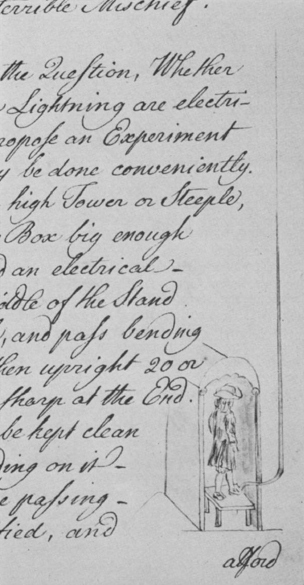 Drawing of Benjamin Franklin's Sentry Box Experiment included in a manuscript of all his early papers on electricity which he sent to James Bowdoin in 1750
Drawing of Benjamin Franklin's Sentry Box Experiment included in a manuscript of all his early papers on electricity which he sent to James Bowdoin in 1750Keep in mind that lightning strikes in those days could cause devastating damage because all buildings were built of wood. A lightning strike on a building could burn down a whole town.
Franklin then wrote of his idea to test whether or not clouds were really electrified:
"To determine the Question, Whether the Clouds that contain Lightning are electrified or not, I would propose an Experiment to be try'd where it may be done conveniently. On the Top of some high Tower or Steeple, place a Kind of Sentry Box big enough to contain a Man and an electrical Stand. From the Middle of the Stand let an Iron Rod rise, and pass bending out of the Door, and then upright 20 or 30 feet, pointed very sharp at the End. If the Electrical Stand be kept clean and dry, a Man standing on it when such Clouds are passing low, might be electrified, and afford Sparks, the Rod drawing Fire to him from the Cloud. If any Danger to the Man should be apprehended (tho' I think there would be none) let him stand on the Floor of his Box, and now and then bring near to the Rod, the Loop of a Wire, that has one End fastened to the Leads; he holding it by a Wax-Handle. So the Sparks, if the Rod is electrified, will Strike from the Rod to the Wire and not affect him."
Benjamin Franklin and Electricity - Collinson publishes his letters
Even though Franklin proposed this experiment to test the existence of "electrical fire" in storm clouds, he had not as yet performed the experiment. After sending all of these letters to Mr. Collinson, Collinson proposed publishing them all together in a book so others could study and learn from Franklin's experiments. Franklin agreed and Collinson had the letters published in a booklet called "Experiments and Observations on Electricity Made at Philadelphia in America." This book later became one of the most reprinted books of the eighteenth century.
In all, Franklin wrote the majority of the information he proposed and discovered in a series of five letters to Peter Collinson (and one to John Mitchel) from 1747 - 1750. It was these five letters that Collinson published in "Experiments and Observations on Electricity Made at Philadelphia in America." You can read each of the five letters here - Benjamin Franklin and Electricity letters.
Benjamin Franklin and Electricity - Franklin takes France by storm
Shortly after publishing the first edition, Collinson sent a copy to the famous French naturalist Georges-Louis Leclerc, Comte de Buffon. Buffon gave the copy to Thomas-Francois Dalibard to be translated into French. While translating the booklet, Dalibard asked for the assistance of a Messr. D'lor, who was a local Parisian practitioner of electrical experiments, for help in performing Franklin's experiments.
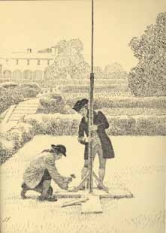 Dalibard Experiment
Dalibard ExperimentIn March 1752, the Comte de Buffon arranged for Dalibard and D'lor to perform some of Franklin's experiments for King Louis XV at the home of the Duke D'Ayen in St. Germain. The King was delighted and amazed with the experiments.
The King's excitement encouraged Dalibard to go ahead and try Franklin's sentry box experiment which he did at Marly-la-Ville on May 10, 1752. This was the first time Franklin's experiment had been performed although Dalibard altered Franklin's suggestions slightly and, rather than using the sentry-box on top of a steeple, used a 40 foot tall pointed iron rod, and, just as Franklin predicted, he was able to draw sparks from the base of the rod when a storm cloud passed over!
This proved beyond any doubt that clouds were electrically charged and changed mankind's understanding of natural phenomena forever. Why was this so significant? Because before this event storms, clouds and lightning were often looked at as agents of divine wrath, rather than as natural phenomena that could actually be predictable and even, in the case of lightning, controlled.
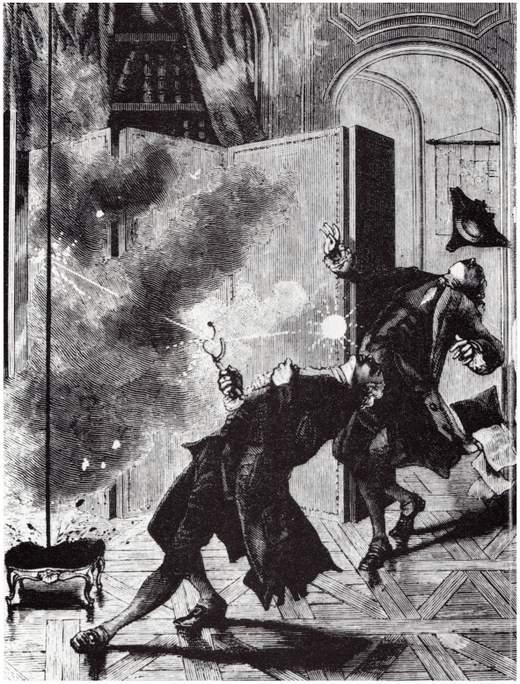 Death of Georg Wilhelm Richmann by Melville Gilbert
Death of Georg Wilhelm Richmann by Melville GilbertThe experiment was repeated by M. D'Lor on the 18th, and within weeks, the "Philadelphia Experiment" was repeated by others all over Europe. King Louis XV even sent a letter of gratitude thanking Benjamin Franklin, Peter Collinson and the Royal Society for publishing the information about lightning rods. You can read a letter from Benjamin Franklin to Jared Eliot in which he mentions the King's letter here.
It should be noted that this whole lightning rod experiment is extremely dangerous and should never be attempted by anyone. Indeed, Swedish scientist Georg Wilhelm Richmann was electrocuted at St. Petersburg while trying to reproduce the experiment on August 6, 1753 due to faulty grounding.
Ben Franklin was not yet aware that his experiment had been performed at all and was working on performing the experiment himself at the same time. Franklin was anxiously awaiting the completion of the steeple on Christ Church in Philadelphia, when the idea crossed his mind that using a kite might afford him the same opportunity of getting an iron rod up in the sky and considerably higher than the steeple would do. He began to set about performing his famous kite experiment, about which undoubtedly EVERY school child in America has heard!
Benjamin Franklin and Electricity
Benjamin Franklin's Kite experiment
Benjamin Franklin performed his kite experiment in June 1752, after the first lightning experiments were performed in France following his proposal, but before he had heard of them. He took his 21 year old son, William, with him. William was the only other witness of the experiment. It should be noted that there are several paintings of Ben Franklin and the kite in which William appears as a young boy, but this is not factually correct. He was actually 21 years old.
You can read the exact way in which the kite was constructed and the experiment was conducted here in Franklin's own words as he printed them in his newspaper the Pennsylvania Gazette on October 19, 1752:
 Benjamin Franklin Kite Experiment Bernard Hoffman
Benjamin Franklin Kite Experiment Bernard Hoffman"As frequent Mention is made in the News Papers from Europe, of the Success of the Philadelphia Experiment for drawing the Electric Fire from Clouds by Means of pointed Rods of Iron erected on high Buildings, &c. it may be agreeable to the Curious to be inform'd, that the same Experiment has succeeded in Philadelphia, tho' made in a different and more easy Manner, which any one may try, as follows. Make a small Cross of two light Strips of Cedar, the Arms so long as to reach to the four Corners of a large thin Silk Handkerchief when extended; tie the Corners of the Handkerchief to the Extremities of the Cross, so you have the Body of a Kite; which being properly accommodated with a Tail, Loop and String, will rise in the Air, like those made of Paper; but this being of Silk is fitter to bear the Wet and Wind of a Thunder Gust without tearing. To the Top of the upright Stick of the Cross is to be fixed a very sharp pointed Wire, rising a Foot or more above the Wood. To the End of the Twine, next the Hand, is to be tied a silk Ribbon, and where the Twine and the silk join, a Key may be fastened. This Kite is to be raised when a Thunder Gust appears to be coming on, and the Person who holds the String must stand within a Door, or Window, or under some Cover, so that the Silk Ribbon may not be wet; and Care must be taken that the Twine does not touch the Frame of the Door or Window. As soon as any of the Thunder Clouds come over the Kite, the pointed Wire will draw the Electric Fire from them, and the Kite, with all the Twine, will be electrified, and the loose Filaments of the Twine will stand out every Way, and be attracted by an approaching Finger. And when the Rain has wet the Kite and Twine, so that it can conduct the Electric Fire freely, you will find it stream out plentifully from the Key on the Approach of your Knuckle. At this Key the Phial may be charg'd; and from Electric Fire thus obtain'd, Spirits may be kindled, and all the other Electric Experiments be perform’d, which are usually done by the Help of a rubbed Glass Globe or Tube; and thereby the Sameness of the Electric Matter with that of Lightning compleatly demonstrated."
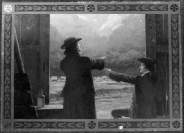 Benjamin Franklin Kite Experiment
Benjamin Franklin Kite ExperimentNote that Franklin was not attempting to draw down a lightning strike upon himself, as is the popular impression that many people hold! Instead, he was trying to attract the electrical charge from the cloud down the kite string and into the Leyden Jar.
Notice also how Ben Franklin emphasized that the bearer of the kite must stand underneath something so as not to allow the ribbon to get wet? And how he emphasized the attaching of the silk ribbon? This is because Franklin understood the principle of grounding. The electrical charge will continue to follow the path of least resistance into the ground.
Franklin connected the silk ribbon to the string in order to prevent the electrical charge from going into his body, because the dry silk ribbon would not conduct electricity. If the silk ribbon was wet, the charge would have passed through the ribbon and into the hand of the bearer. Likewise, if the string was allowed to touch the door frame, the charge would have passed through it instead. This is why electrical circuits in homes and buildings are "grounded." They are connected to the ground, normally by some type of wire, in order to prevent a build up of electrical charge in the circuit that could kill someone if they touched it. Instead, the charge follows the grounding wire into the earth.
By late 1752, lightning rods were installed on several public buildings in Philadelphia, including the Academy of Philadelphia (which was later the University of Pennsylvania) and the Pennsylvania State House (which we now know as Independence Hall).
In his 1753 edition of Poor Richard's Almanack, Franklin was able to publish for the first time a definitive recommendation for protecting houses and other structures from lightning strikes:
"It has pleased God in his Goodness to Mankind, at length to discover to them the Means of securing their Habitations and other Buildings from Mischief by Thunder and Lightning. The Method is this: Provide a small Iron Rod (it may be made of the Rod-iron used by the Nailers) but of such a Length, that one End being three or four Feet in the moist Ground, the other may be six or eight Feet above the highest Part of the Building. To the upper End of the Rod fasten about a Foot of Brass Wire, the Size of a common Knitting-needle, sharpened to a fine Point; the Rod may be secured to the House by a few small Staples. If the House or Barn be long, there may be a Rod and Point at each End, and a middling Wire along the Ridge from one to the other. A House thus furnished will not be damaged by Lightning, it being attracted by the Points, and passing thro the Metal into the Ground without hurting any Thing. Vessels also, having a sharp pointed Rod fix'd on the Top of their Masts, with a Wire from the Foot of the Rod reaching down, round one of the Shrouds, to the Water, will not be hurt by Lightning."
Remember the statement mentioned earlier that it was commonly believed in Franklin's day that lightning strikes were acts of God, rather than natural phenomena? Well, as the idea of the lightning rod began to spread around the colonies, many people began to object to their use based on the reasoning that purposefully subverting a lightning strike would be subverting the will of God!
Franklin clearly objected to this notion in a letter he wrote to Cadwallader Colden in which he states that protecting one's self from lightning is no different than protecting one's self from rain, hail or sunshine by constructing a roof over one's head! People didn't consider building a roof to be subverting "the will of God," and neither was putting a lightning rod on your house! You can read the letter from Benjamin Franklin to Cadwallader Colden here.
Benjamin Franklin and Electricity - The Royal Society
The Royal Society of London was created in 1660 by Royal Charter from King Charles II of England in order to study and disseminate scientific understanding of the world. Peter Collinson had introduced Benjamin Franklin's letters concerning electricity to the Royal Society, but the Society as a whole had been slow to realize the significance of his work.
By 1753 though, after the publishing of Franklin's letters and their widespread acceptance throughout Europe, the Royal Society inducted Franklin as an honorary member and awarded him its highest honor, the Copley Medal. The Copley Medal is awarded by the Society to those who make the most outstanding contributions to scientific understanding.
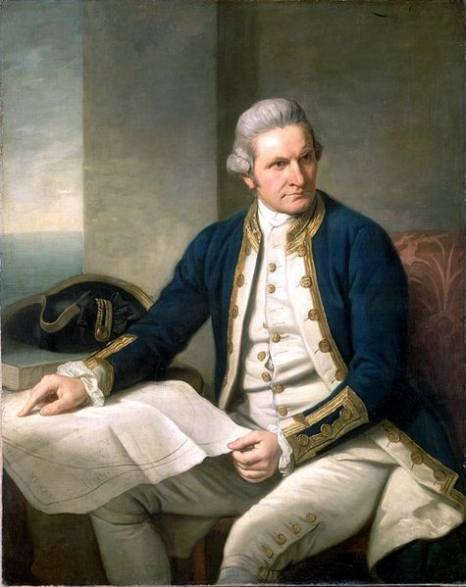 Captain James Cook
Captain James CookSome other people you may have heard of who have received the Copley Medal include Captain James Cook (1776), the first European to discover the Hawaiian Islands, Sir William Herschel (1781) for his discovery of the planet Uranus, Alessandro Volta (1794) for his discoveries regarding electric cells (and from whom we get the word "volts" to measure electricity), Michael Faraday (1832) for his contributions to the fields of electromagnetism and electrochemistry, Charles Darwin (1864) for his contributions in zoology, geology and botanical physiology, Albert Einstein (1925) for his theory of relativity and contributions to quantum theory and... Stephen Hawking (2006) for his contributions to theoretical physics and theoretical cosmology! Quite the group to be numbered among, eh?
In addition to his induction into the Royal Society, Ben Franklin was also inducted into the French Academy of Sciences in August 16, 1772 for his contributions to science. At the time he arrived in Paris during the American Revolution, he was one of only eight foreigners to have been inducted into this prestigious society.
Benjamin Franklin also received many other honors, honorary doctorates and was inducted into other scientific societies because of his contributions about electricity. You can read a complete list of the honors received by Benjamin Franklin here.
Over the next several years, Franklin continued to collect information about lightning strikes and the way lightning rods were being constructed and used. On June 21, 1753 he published this request in the Pennsylvania Gazette for information on lightning strikes:
"Those of our Readers in this and the neighbouring Provinces, who may have an Opportunity of observing, during the present Summer, any of the Effects of Lightning on Houses, Ships, Trees, &c. are requested to take particular Notice of its Course, and Deviation from a strait Line, in the Walls or other Matter affected by it, its different Operations or Effects on Wood, Stone, Bricks, Glass, Metals, Animal Bodies, &c. and every other Circumstance that may tend to discover the Nature, and compleat the History of that terrible Meteor. Such Observations being put in Writing, and communicated to Benjamin Franklin, in Philadelphia, will be very thankfully accepted and acknowledged."
Benjamin Franklin and Electricity - Perfecting the design
Franklin was able to perfect his design for lightning rods as a result of the information he received over the next few years. Reports came back that showed that conductors could melt if struck by lightning if they were not of sufficient size, that electricity would spread out across the surface of the ground where the conductor meets the ground (this is called a ground arc) and that holes could be blown into the earth where the conductor met the ground in an actual lightning strike.
Franklin was pleased with each new instance he learned of because each one increased his understanding of the laws of electricity. As a result, he sent a new and improved design for the lightning rod to Scottish philosopher David Hume in January 1762.
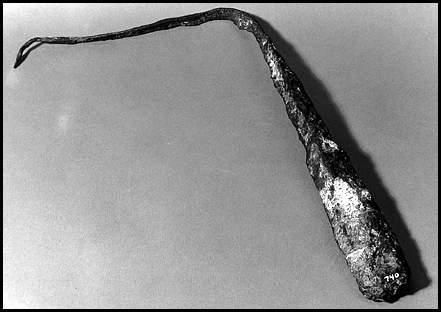 A damaged lightning rod, believed to be one of the originals from Franklin's time Source: The Franklin Institute
A damaged lightning rod, believed to be one of the originals from Franklin's time Source: The Franklin InstituteIn it, he recommended that the rod be constructed of steel, should be five to six feet in length and be sharpened to a point. He said that any building that was longer than a hundred feet should have one positioned at both ends that were connected by a conductor. He recommended that all conducting pieces be at least a half inch in diameter, continuous and connected on the outside of the building (some of them were routed through the inside of the building before) and that any connecting joints should be filled with lead solder for a good connection.
He stated that the grounding conductor should be one inch in diameter and should be an iron bar driven ten to twelve feet into the ground and at least ten feet away from the building. He recommended that the ground rods be painted to reduce the possibility of rusting and also connected to a well if possible. Connecting to a well would cause the electricity to be conducted even deeper into the earth.
Franklin's earlier design was actually quite dangerous, but this 1762 design has proven reliable and still remains the basis for all contemporary lightning protection systems in the world till this day!
The installation of lightning rods on buildings became so popular in the colonies that by 1782 there were 400 lightning rods installed in Philadelphia alone.
Oh and by the way, as lightning rods began to be installed on buildings throughout the colonies and Europe, a funny distinction arose between lightning rods on buildings in the colonies verses those in London.
Since Franklin had discovered that sharply pointed rods were more likely to attract lightning and prevent strikes, King George III decided to have bluntly pointed lightning rods installed on his palace, reasoning that a bluntly pointed rod would be less likely to attract a lightning strike and cause damage. He obviously didn't understand that attracting lightning to prevent a strike was the whole point!
Colonists began to erect pointed rods everywhere in order to support Franklin's theories, but also to repudiate the King's theories! Thus it became a political statement that they were rejecting the King by erecting a pointed lightning rod! The British thought it was just one more way for those pesky colonists to show their disobedience, ha!
Benjamin Franklin and Electricity -
Franklin's Bells
After learning about the success of his lightning rod experiment in Europe, Benjamin Franklin installed a lightning rod on his own home to further study the phenomenon. He installed a tall, insulated rod on the roof that was connected to a wire running down through the inside of the house. The wire was connected to a bell. When a thundercloud passed over, the electrical charge from the storm would pass down the rod and wire and the positively charged bell would repel a small ball suspended between itself and a second bell, thus ringing and creating an alarm each time an electrified storm was near.
This is a graphic showing the Franklin's Bells experiment:
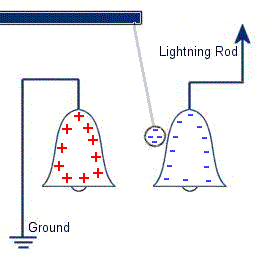
And this is a painting by the British artist, Mason Chamberlin, showing Franklin with his own Franklin's Bells setup. The painting was commissioned by a wealthy Virginia landowner and friend of Franklin's who lived in London, Colonel Philip Ludwell III.
Franklin actually sat for this painting so it is very lifelike and shows exactly what Franklin's home and person looked like. This was said to be one of Franklin's favorite paintings of himself because it showed his likeness so accurately.
The painting shows Franklin in his study while lightning strikes outside the window. You can also see a lightning rod on his house. Franklin is looking at a set of "Franklin's Bells," which would ring whenever an electrical charge was striking the rod. Benjamin Franklin would then use the captured electricity to perform other electrical experiments!
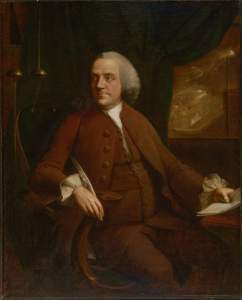 Benjamin Franklin of Philadelphia by Mason Chamberlin, 1762
Benjamin Franklin of Philadelphia by Mason Chamberlin, 1762Sometimes when a strong thundercloud passed over, the electric spark between the two bells would be so bright and would crackle so loud that it would eliminate the entire room in Franklin's house. Franklin's wife Deborah was so frightened by the electrical arcs that she wrote to Ben while he was in Europe asking him how to turn the thing off!
As a result of studying this setup, Franklin discovered that storms could be positively or negatively charged and that sometimes the lightning strike was actually going up from the earth into the cloud, rather than coming from the cloud down to the earth!
Benjamin Franklin and Electricity
Home Experiment
This is a basic electrical experiment that anyone can recreate in their own home. It is based on the Franklin's Bells model and is used in classrooms all over the world to demonstrate how electricity works. You can actually reproduce the experiment with a few household items such as pop cans, a pen and a tv! Just follow these instructions and look at the pictures:
You will need:
Two empty soda cans. A ball-point pen A few inches of thread Two square feet of aluminum foil Cellophane tape Two wires (alligator test leads work well) A TV or computer monitor
Just look at the picture to put it all together. It's pretty self-explanatory.
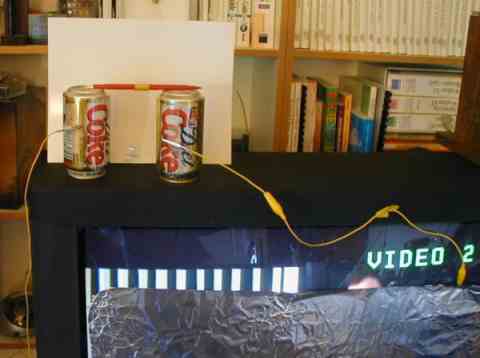
Spread the aluminum foil across the front of the screen to collect the electrical charge and connect one end of one of the wires from the aluminum foil to the first can. The electrical charge will flow from the screen through the foil through the wire and to the can.
Connect the other wire from the second can to a pipe or metal of some kind, or you can just hold onto it because your own body is a sufficient grounding source. (The current will be way too small to hurt you so don't worry about being electrocuted!)
Tape the pen over the cans and hang the pop top with the string down between the cans. This will cause the pop top to swing back and forth between the two cans. This is a basic electrical circuit. Every type of electricity you use on a daily basis is a variation of this simple circuit from the light switch in your room to Duracell batteries to massive electrical power stations conducting billions of volts of energy every second!
Click here to see an animated version of what it should like.
Benjamin Franklin and Electricity -
Effects on the Revolution
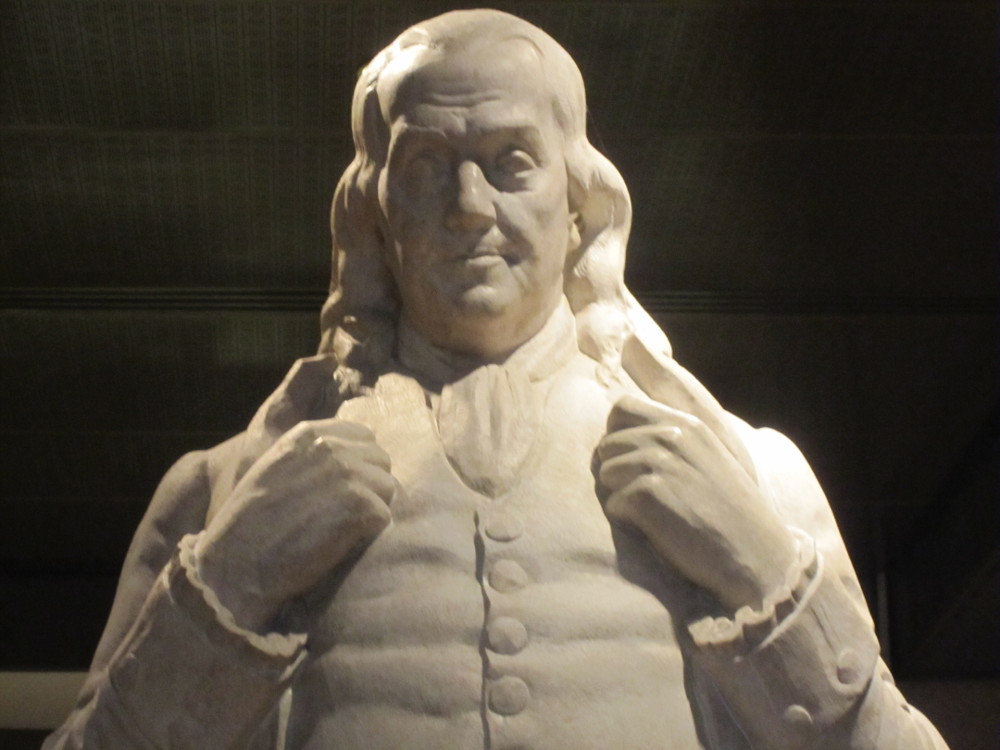
When Benjamin Franklin traveled to France on a mission to garner French support for the American rebels during the Revolutionary War, he arrived there with a huge advantage that was directly a result of his studies in electricity - fame! Benjamin Franklin's studies, discoveries and inventions with electricity were well known and highly regarded in France. Franklin's fame was so huge in France that he had a hard time even believing it!
He wrote this statement to his daughter back in America:
"My picture is everywhere, on the lids of snuff boxes, on rings, busts. The numbers sold are incredible. My portrait is a best seller, you have prints, and copies of prints and copies of copies spread everywhere. Your father's face is now as well known as the man in the moon."
This fame gave Franklin a huge advantage. He was received with open arms everywhere in France, including by King Louis the XVI. His main mission was to acquire French support for the Continental Congress in their battle against Great Britain. He wanted money and military support - and he got it!
The French involvement in the Revolutionary War was key in several ways - many French soldiers and generals fought alongside the Continental soldiers, including the Marquis de Lafayette, a General who worked closely with George Washington. The French Fleet defeated the British Fleet at the Battle of the Chesapeake and trapped Cornwallis at the Siege of Yorktown, which hastened the British surrender to the Continental Army on October 19, 1781
Benjamin Franklin and Electricity -
Discoveries and Contributions
This is a list of Ben Franklin's discoveries and contributions to the field of electricity:
- The idea that electricity is a single force that is never created or destroyed, but merely transferred from one place to another. This is called the Principle of Conservation of Electric Charge.
- The discovery that a pointed object, rather than a blunt object, would more efficiently and more safely attract an electrical charge.
- The idea of grounding - that the electrified object must be touching something in order to maximize the electrical spark and provide a path for the current to reach the ground.
- The terms plus and minus, and positive and negative, when describing electrical charges.
- His discovery that the inside contents and the outside layer of a charged Leyden jar were charged oppositely and in exactly opposite proportions.
- The terms charging and discharging when describing the movement of electrical charge.
- The fact that the charge in a Leyden Jar was actually held in the glass itself.
- He first used the terms condenser and conductor.
- The fact that glass can hold and transfer electric charge as a property of itself no matter what the shape of the glass.
- That electrical charge can be stored and transferred through a series of glass panes connected with lead plates and wires. He called this an electric battery. The first time the term had been used or such an object had been created.
- His suggestion that a tall, insulated rod could be used to determine if thunderclouds were electrically charged.
- The idea of the striking distance, meaning that a larger electrical charge would strike out at a further distance.
- The suggestion that people should stay away from tall objects such as trees or steeples during storms in order to avoid being electrocuted!
- The fact that lightning is electricity.
- The suggestion that a tall, insulated rod could be used to protect against lightning damage - otherwise known as a lightning rod!
- He discovered that clouds are normally negatively charged so that in most cases the electrical strike is actually going up from the earth into the cloud, instead of down from the cloud into the earth!
To learn about other interesting facts about Ben Franklin, go to our Ben Franklin Facts page.
Facts About Benjamin Franklin 2
Revolutionary War and Beyond Home
Like This Page?
© 2008 - 2022 Revolutionary-War-and-Beyond.com Dan & Jax Bubis










Facebook Comments